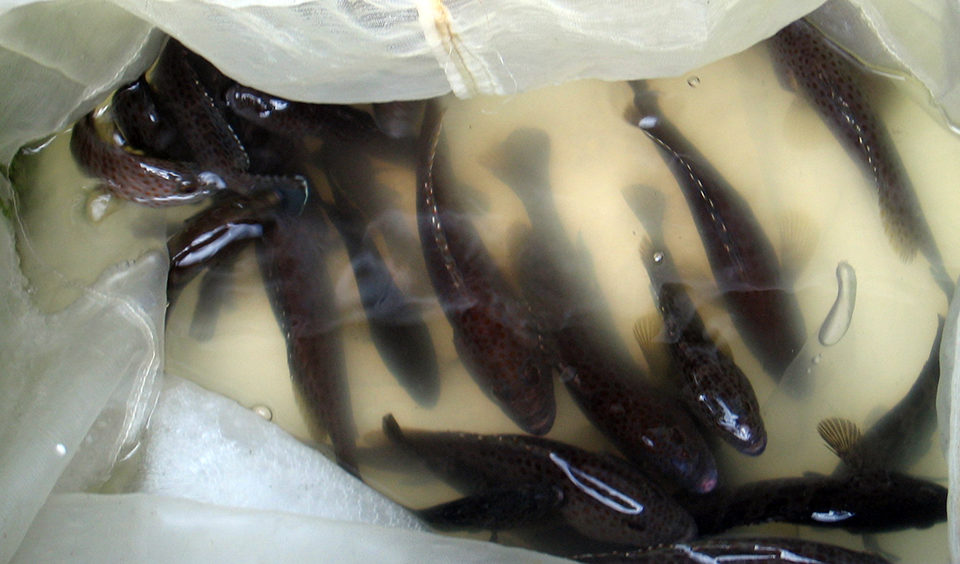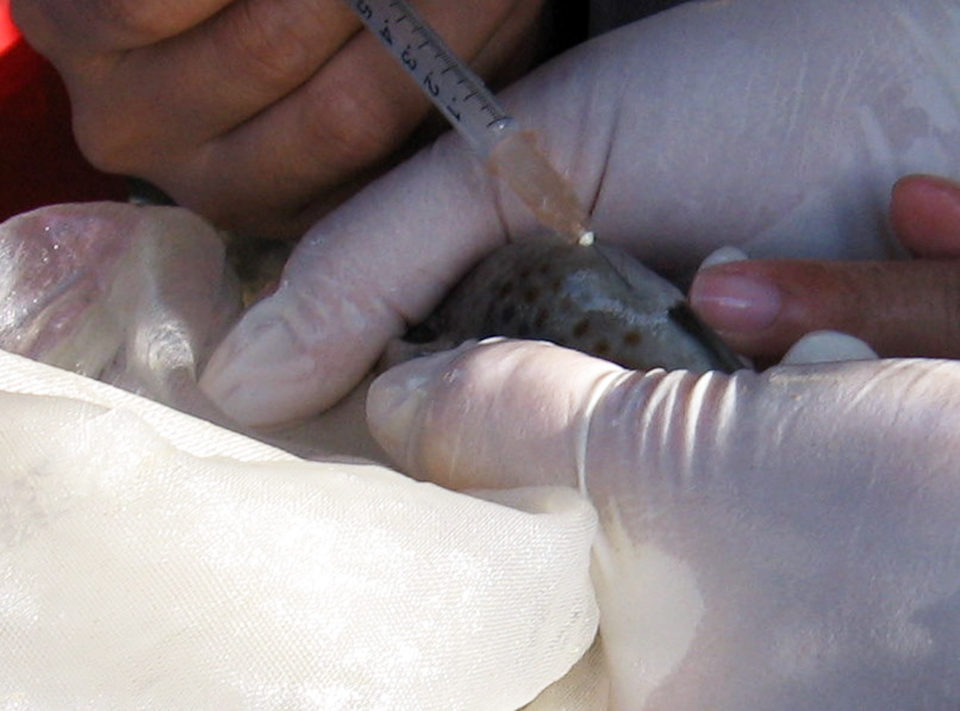Husbandry techniques must take stress into account to ensure effectiveness of vaccines

Disease is a common consequence of rearing animals in high densities under conditions that may stress them and favor the growth and potential spread of pathogens. Many consider disease an inevitable consequence of aquaculture production that only a lucky few avoid, but measures can be taken to lessen or avoid the effects of disease outbreaks.
Prevention first
Typically the best approach to disease control is prevention. Treating sick animals is usually less effective and quite a bit more expensive.
Prevention entails a wide range of activities that proactively manage the pathogen types and loads, and the stress the cultured animals are under. Foremost among the tools in the arsenal for prevention of diseases are vaccines.
Vertebrates such as fish have immune systems that can produce long-term levels of protective immunity. The immune systems of invertebrates like shrimp, however, do not have the ability to develop either protective antibodies or the long-term memory of exposure that is considered the hallmark of protective immunity. Fish can be vaccinated, while shrimp can only be stimulated in a nonspecific manner.
Vaccine evolution
Fish vaccines were first commercialized in the United States in the mid-1970s. The first products were prepared from pathogenic bacteria grown in fermentor machines that provided a controlled environment, killed with formalin and either concentrated by centrifugation or packaged as is.
The very first vaccines were applied by injection with good success, although at some risk to personnel because accidental injections can seriously injure or kill. This was a very stressful means of immunizing fish, requiring each fish to be handled. With subsequent mortalities, a new method was needed.
It was discovered that fish could be immunized by being bathed in a diluted suspension of the bacteria. For some years, this became the norm with variations, such as spray applications and long-term exposures at very high dilutions of concentrated products becoming the standard. Salmonids were the target of these first products.
As the aquaculture industry grew, there was a move away from this approach back to injection. Injection machines were developed, and trained crews took some of the risk out of the process, although it still caused stress.
Injecting protective antigens in combination with adjuvants – typically mineral oil or other lipids that acted as a depot for slow release and/or contained substances that strengthened the immune response – became the common practice. Vaccines termed bacterins, since they were formalin-inactivated, whole-cell suspensions, were routinely applied this way, often as mixtures of multiple strains.
Virulence determinants
Ideally, the best vaccines are those that target against the components of the pathogen known as virulence determinants, which are critical to its ability to produce disease. Vaccines that do not contain virulence determinants are not as desirable, as they may require the need to revaccinate and may be less than 100 percent effective, requiring the use of antibiotics or other treatments.
Through ongoing research on virulence mechanisms, the virulence determinants for many fish pathogens – whether viral, bacterial, protozoan or fungal – are now known. These will be the target of a generation of new and improved vaccines.
Emerging technologies
As the farmed production of fish continues to increase globally, more species are being farmed in increasing numbers, and disease is a constant problem. Research into alternative delivery methods has resulted in a number of exciting technologies that offer the promise of more powerful and effective vaccines. This includes live attenuated vaccines, oral delivery systems and DNA vaccines.
Live attenuated vaccines
Live attenuated vaccines typically consist of living mutants of the pathogen that are fully functional in most ways but do not proliferate long enough to produce pathology. They do, however, allow the immune system to develop a protective response. This response is often a powerful one, as the vaccination process mimics real infection.
This idea is the basis for one of the polio vaccines that is widely used in humans. Researchers have successfully demonstrated the viability of the approach for many bacterial diseases and pathogens in aquatic environments, including furunculosis due to Aeromonas salmonicida, Edwardsiella ictaluri, an important pathogen in farmed catfish, and many others.

Oral applications
In the early years of vaccine development, the oral delivery of product was much desired. After all, what could be easier than milling the protective antigens into feed and feeding the animals to immunize them? No handling of the fish and subsequent stress was required.
A number of novel oral approaches have been developed in recent years. While challenges remain, it is inevitable that some fish vaccines will be delivered orally. The ultimate promise of oral vaccines is that a single feeding with targeted delivery could ensure high levels of protective immunity for very little cost and with no stress on the fish.
DNA vaccines
In the last decade, vaccines that consist of DNA with specific genes that encode for protective antigens have become useful tools that, when injected, produce long-term, highly protective immune responses. There are still serious regulatory hurdles for DNA vaccine technology, yet it offers great promise for many diseases.
Although the primary application of DNA vaccines is by injection, some studies suggest that oral application may be suitable. This approach lends itself particularly well to viral vaccines, as it eliminates the need to culture large amounts of virus. Successful protective immunity has been noted with many viruses.
Limit stress, pathogens
The advent of these technologies and their widespread application will further strengthen the arsenal that fish farmers can apply in preventing the impacts of profit-limiting diseases and further decreasing the reliance on antibiotics. However, it is important to keep in mind that even with these advances, the role of stress in the disease process cannot be ignored. Husbandry techniques must take this into account to ensure that vaccines protect animals at the highest possible levels.
Furthermore, the availability of highly efficacious vaccines should not be viewed as a sole solution in disease management. Every effort should still be made to minimize the presence of pathogens and their ability to spread in susceptible populations.
(Editor’s Note: This article was originally published in the March/April 2009 print edition of the Global Aquaculture Advocate.)
Now that you've finished reading the article ...
… we hope you’ll consider supporting our mission to document the evolution of the global aquaculture industry and share our vast network of contributors’ expansive knowledge every week.
By becoming a Global Seafood Alliance member, you’re ensuring that all of the pre-competitive work we do through member benefits, resources and events can continue. Individual membership costs just $50 a year. GSA individual and corporate members receive complimentary access to a series of GOAL virtual events beginning in April. Join now.
Not a GSA member? Join us.
Author
-
Stephen G. Newman, Ph.D.
President and CEO
AquaInTech Inc.
6722 162nd Place Southwest
Lynnwood, Washington 98037 USA[109,111,99,46,104,99,101,116,45,110,105,45,97,117,113,97,64,109,119,101,110,103,115]
Tagged With
Related Posts

Innovation & Investment
Blue food solutions
Although state-of-the-art research has led to breakthroughs in cost efficiency, productivity and sustainability, further advances will be needed to support expansion of the industry to meet growing seafood demand. The North Atlantic Seafood Forum identified challenges and proposed solutions for varied issues.

Health & Welfare
Hybrid, channel catfish show similar immune responses to ich parasite
In a study, the authors evaluated the immune responses and host protection of hybrid catfish and channel catfish against the ich parasite (Ichthyophthirius multifiliis).

Health & Welfare
Oral vaccine delivery effective in reducing salmon diseases
Oral vaccination can be done with virtually all fish sizes and is a relatively stress-free and inexpensive approach. The authors developed a novel oral vaccine delivery system that was found effective against infectious salmon anemia and salmonid rickettsial septicemia at salmon farms in Chile.

Health & Welfare
Sizing up TiLV and its potential impact on tilapia production
An international research effort has commenced to find a solution for Tilapia Lake Virus (TiLV), a contagion causing high rates of mortality in farmed and wild tilapia stocks in Israel, Colombia, Ecuador, Egypt and Thailand.


